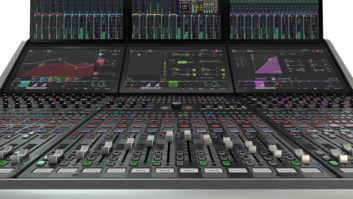Sky Sports has recently employed a new workflow to capture the sound of boxing.
The broadcaster is using microphones inside and outside the ring to help viewers hear the communication between boxers and their coaches, and even the two opponents.
TVBEurope spoke to Sky Sports Boxing sound team, Nik Taylor Pugh, Mark Finch, Dan Shaw and Carlton Waghorn to hear more.
Why did Sky Sports want to enhance the audio of its boxing coverage?
We always look to improve our audio delivery on productions to ensure we produce high quality coverage for our viewers. Whether it’s the inclusion of more music elements to the show editorially, for example a tension drone during the MC’s introduction of the fighters or changing the placement of, or type of microphones within a venue.
What is the biggest challenge of capturing the sound of a fight? Is it that you can’t get mics up close, or can the crowd be too noisy?
There are several challenges. For example, the British Boxing Board of Control does not allow us to mic up the referee. We would undoubtedly be able to utilise this into the fight FX mix to aid with punch pick up if this was permitted, so we have to capture sounds from the fight in other ways.
Another factor to take into account is rigging and derigging time constraints, we could have shotgun mics suspended above the ring, pointing down at the canvas for example but due to various factors including the time we are able to enter and exit the venue, this isn’t always possible. Everything needs to be rigged and checked ahead of going on air for seven hours.
The venues also differ from one job to the next, some venues by design are louder and it’s not just crowd noise we have to contend with, but the PA install as well. VME are the providers of the event PA systems on Boxxer events – and we work closely together to ensure our broadcast is not impacted too much by the venue PA levels. A key factor to delivering a coherent mix from a very loud live event is FX mic placement. Having FX mics far away from the PA line arrays would incur slap back, so we prefer to have our 5.1 Soundfield mic near to, but out of the line of fire of a PA stack. This minimises the slap effect to some degree, however when this isn’t possible – we would delay our sources feeding our main mix output to match the time difference in fx mic pick up of the PA, whilst simultaneously sending the same source to the PA un-delayed. This tightens up the mix and is mostly notable on the ring-walks.
What kind of mics are you using, where are they placed around the ring, and why is each mic placed there?

We install FX mics on each corner of the ring – facing diagonally across the ring to the opposite corner. We previously used Sennheiser MKH416’s, but after some experimentation with a few medium format shotguns, we found the DPA 4017 Shotgun Microphone to have slightly better off-axis rejection and better pick-up whilst being a smaller format and therefore less conspicuous on camera.
We also opted to change our inter-round boom pole mics to DPA 4017s as they are lighter than other similar mics. The boom poles are used to capture what the trainers are saying to the boxer in-between rounds.
We still use MKH416’s as FX mics on cameras around the perimeter of the ring. But also, we use an MKH418 stereo shotgun on the ringside Jib camera – this gives us flexibility to capture what’s going on in and around the ring.
We have many other positions on a boxing production where we use microphones. One such position is our ringside presentation position where we cater for a presenter and up to five guests at a time. VME provide our radio stick mics and IEMs on the boxing – all Sennheiser kit. On events where the sound pressure levels ringside are very high, we’d struggle to hear our presenter and guests over the crowd and PA levels picked up on the handheld stick mics alone. But also, this would mean they would struggle to hear each other, as their mics are mixed back into their respective IEM mixes too. So we looked into potentially finding a mic head to fit the Sennheiser 5200 series handheld body that had better rejection of off-axis spill with good clarity and detail providing intelligibility in a high SPL environment, so we tried the DPA d:facto 4018 head that has a supercardioid polar response. In combination with having the individual IEM mix elements on the Calrec Artemis mixer in the truck, we found we had more control over spill and therefore intelligibility of the IEM mixes for the end user. And for our programme mix we found these heads to improve the intelligibility of our talent over the venue noise.
Another position on the boxing production ringside is commentary. We generally have three commentators, each with their own commentary unit. We prefer to use the Glensound inferno Dante commentary units as we need to be able to rig this position quickly due to time constraints. And they only require a Cat5 RJ45 connector to a switch ringside, compared to the older analogue commentary units that would require a fair bit of copper connectivity – which was time-consuming to rig and often would present other issues like induced interference from nearby mains distribution for example.
The commentary team have tried Sennheiser HMD25 and 26 headsets in the past. But we found that the gooseneck mic had to be in the sweet spot to sound ok and often it would get accidentally knocked, only to then get moved back manually which introduced handling noise. So, we reverted back to using the good old Coles 4104 ribbon lip microphone. This ensured that the commentator would hold the microphone directly in front of their mouth. And as the Coles Lip mic has a bi-directional polar pattern, the off-axis spill sounded better too compared to a headset, which we found would add a lot of thin high end to the mix due to the polar response pattern being super cardioid. Ultimately, the smaller the rear pick-up response is, the thinner the spill sounds. And this in turn would have an impact on the overall mix. Sometimes it is better to have a fuller sounding spill than to try and negate it.
All presentation positions require back-ups in case of technical failures. We use Electrovoice RE50’s as back-up mics in presentation and reporter positions including backstage dressing room interview position. For commentary, we use a battery-powered SQN mixer which, in case of power failure ringside enables us to continue commentary.

How are the mics attached to the audio mixing desk?
We connect our mics and various feeds to and from the truck via Calrec Hydra fixed format stage boxes. These are connected using fibre on LC type connectors which provide a main and a back-up for redundancy. The patching of the connections is stored within the Calrec Artemis Boxing show file so are instantly recalled upon loading the show. The commentary units use Dante and connect back to the truck via a network switch ringside. All other mics and cabled IEM feeds are connected via copper multi’s back to the truck.
What changes have you had to make to the mix to deliver a more immersive experience?
We had to utilise more outputs of the console. And as we’d deliver 5.1+Stereo on our HD output and Atmos on our UHD output, the line up times with MCR were longer. We would have several sources on the Calrec mixer that we could place into the heights mix, including graphics wooshes that we’d have on the desk twice. The first instance of Gfx woosh would be sent to the ‘Bed’ mix and the second instance would be delayed and sent to the front left and right heights only. This would give the impression of the woosh sound flying up over your head.
What’s been the biggest challenge of developing the new immersive sound?
Timing is key when using immersive sound technology, and can often be the biggest challenge when delivering a high-quality, seamless immersive sound experience.
Have you had any feedback from viewers about the new immersive audio?
So far, we have not received any feedback from viewers about the new immersive audio, but are always talking to colleagues internally about how the broadcast comes across and taking these insights into account to make necessary improvements.
Have you shared your learnings from the project with other areas of Sky Sports, and how could your project be adapted for things like football, cricket, darts etc?
Each production has its own challenges to overcome. Boxing and Darts have a lot in common given the crowd noise and PA requirements. But overall we always share our findings with colleagues on other productions as they may wish to use similar kit to overcome issues like ours. As a whole, we are always striving for the highest standards and are aware there is a lot to learn from how other teams and sports produce their coverage.







